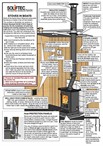... install it safely
Take account of the fire and carbon monoxide risks linked to introducing a solid fuel stove.
And; even if you are refitting the cabin and keeping the stove… the information on how to stop wood and other combustible surfaces next to the stove from  catching fire should be of interest to you.
catching fire should be of interest to you.
Remember also that stoves consume huge amounts of air so you need to recalculate your boat's ventilation requirements.
Follow the stove manufacturer's instructions for installing in a boat, but if these are not available, you can find good advice based upon the BS 8511:2010 Code of Practice on this flyer produced by Glyn Hughes of Soliftec.
A stove installed in-line with BS 8511 will not just improve the safety of you and your crew, it will also likely save you money because stoves having an insulated chimney will mean you will burn less fuel.
Pointers to keep in mind:
- Choose an appliance that the manufacturer or supplier says is suitable for boats and that has a heat output matched to the cabin size, generally not greater than 4.5kW.
- Use a professional who knows what's needed to install it to the manufacturer's instructions for installation in boats, or the new BSI code of practice BS 8511.
- Locate for the stove away from soft furnishings such as curtains, sofas or beds and make sure it doesn't block or obstruct any passageway passageways.
- Ensure any combustible materials near to the appliance or chimney are properly heat insulated; or, that the appliance is placed at least the minimum distance away from surrounding surfaces stated in the manufacturer's instructions.
It is important that any nearby wooden structures do not get any warmer than 65°C above the general cabin temperature, otherwise pyrolysis of the wood can occur.
- The appliance should be securely fastened either to the hearth or to the bulkhead or wall of the craft. Don't forget, the hearth should also be secured to the boat's structure.
- Use insulated chimney sections inside and outside of boat. They should be of the diameter recommended by the stove manufacturer, and never less than 100mm.
- The chimney length should be at least 2m long from flue outlet on appliance to top of chimney. Ideally it will be all straight, but if not, never with an angle more than 30º from the vertical.
- All chimney sections need to be effectively connected to be safe.
- The chimney should be adequately supported as it passes through the cabin roof to prevent the weight being taken on the stove. As the chimney passes through the cabin roof it should be weather-sealed.
- The outside chimney section can be removable for navigating under bridges and through tunnels and should be at least 600mm above roof height.
- Rain hats or cowls on chimneys should be open-sided to allow a good flow of flue-gases.
On the subject of tiles...
The question sometimes arises 'ceramic or porcelain?'
Porcelain tiles are recommended by the Ceramic Tile Council. It has a page about the subject here: https://www.britishceramictile.com/blog/heat-resistant-tiles
Soliftec also adds a reminder to use a heatproof tile adhesive.
You need calcium silicate (cs) board backing to create the insulating protection to any woodwork in the surround. However some cs boards can be very soft on the surface, which means that tiles don't stick to them well. Soliftec's tip is to add in front of the CS board, a thin sheet of cement board on which to mount the tiles.
Latest ventilation requirements
It is now known that solid fuel stoves consume huge amounts of oxygen in use.
BS 8511 Code of Practice published a revised ventilation formula to take account of this factor and it introduced new value for stoves known as 'H'.
This is how the minimum ventilation area in mm² is now calculated:
2200 x (U) the input rating of all unflued fuel burning appliances, in kilowatts
+ 440 x (F) the input rating for open-flued fuel burning appliances, in kilowatts
+ 550 x (H) the nominal output rating of open-flued solid fuel appliances, in kilowatts
+ 650 x (Berths) the number of persons for which the accommodation space is designed
Room-sealed appliances are not considered in ventilation calculations as their air supply is not drawn from the craft interior.
The total value from the formula should then be split half and half between high and low level ventilation.
